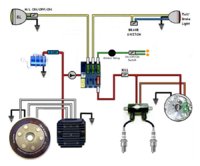davem222
davem222
Hey guys,
As some of you may recall, I recently, and idiotically, burned out my Pamco for my new build by not grounding the circuit (sigh). So I've got my new Pamco in hand and am a bit trigger shy lol. Quick question: can I simply have one ground going to the engine (to the bolt on the top of the bottom end, directly below the carbs) and all of the grounds tied into that, or do I need everything grounded separately? I would really REALLY like to not screw it up again, lol. Thoughts?
Also, as a side note, how does the engine or frame constitute a "ground"? They're separated from the earth by an insulator, rubber tires. What am I missing here theoretically?
Thanks guys!
Dave
PS: I'm attaching my wiring circuit fyi, please note that the ground from the PMA is a mistake and I know it
As some of you may recall, I recently, and idiotically, burned out my Pamco for my new build by not grounding the circuit (sigh). So I've got my new Pamco in hand and am a bit trigger shy lol. Quick question: can I simply have one ground going to the engine (to the bolt on the top of the bottom end, directly below the carbs) and all of the grounds tied into that, or do I need everything grounded separately? I would really REALLY like to not screw it up again, lol. Thoughts?
Also, as a side note, how does the engine or frame constitute a "ground"? They're separated from the earth by an insulator, rubber tires. What am I missing here theoretically?
Thanks guys!
Dave
PS: I'm attaching my wiring circuit fyi, please note that the ground from the PMA is a mistake and I know it



